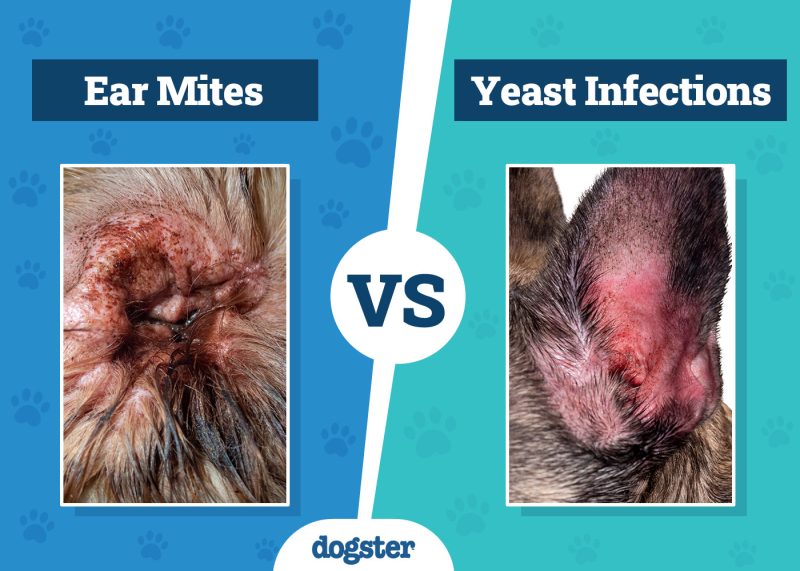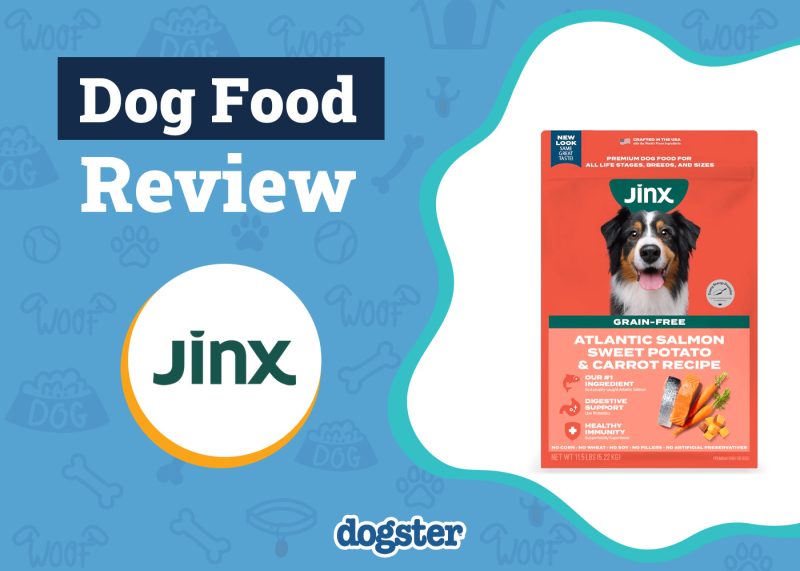In this article
It’s a very exciting time when your dog is pregnant. In most cases, things will go smoothly, and you’ll end up with several new puppies in just 2 months’ time. Occasionally, though, things don’t go as planned, and complications arise in your dog’s pregnancy.
To ensure that you have the information you need to accurately gauge your pet’s pregnancy, we put together the following post about the most common abnormalities of dog pregnancy. Keep an eye out for these signs, but hopefully, you’ll never see them, and your dog’s pregnancy will go by without a hitch! If you have any concerns about your dog’s pregnancy or feel that something isn’t quite right, it’s best to consult with your veterinarian promptly.

Before and During Whelping
Not every complication with pregnancy happens while your dog is still pregnant. Certain ones won’t become issues until after your dog has finished whelping. The abnormalities that we’re about to discuss happen during pregnancy and birth.

1. Pregnancy Loss
What Is it?
Pregnancy loss, or miscarriage, is the death of a fetus during any stage of the pregnancy. The signs of a miscarriage will have different presentations, depending on the stage at which it occurs. Embryonic deaths in dogs usually occur before day 25 of gestation and generally go unnoticed, as the embryos are reabsorbed. Fetal deaths can also occur after day 30, at which point they can be detected by your vet using an ultrasound and may result in abortion or mummification.1
Causes
Miscarriages can be caused by many different factors in dogs. Bacterial and viral infections are believed to be common causes. Bacteria like E. coli, Pasteurella, Pseudomonas, and Staphylococcus are often associated with a miscarriage but can also be present in healthy dogs, leaving space for doubt and misinterpretation. That said, bacteria like Brucella canis will result in late-term miscarriages in otherwise healthy dogs. Canine herpesvirus is just one of the viruses that can lead to pregnancy loss in dogs, mummification, or stillborn puppies.

Hormonal issues, resulting in low progesterone levels due to medication or endocrine imbalances, can also lead to a miscarriage. Other possible causes include accidents and trauma, which could also result in other pregnancy complications.
When to Call the Vet
When puppies die in utero, there can be different outcomes depending on the cause and stage of pregnancy in which the fetal death happens. Tiny embryos and fetuses can be reabsorbed, but if the puppies are more developed, they can become mummified. In-utero deaths can also lead to infections. If your pregnant dog looks unwell, has a higher-than-normal body temperature, is lethargic, has foul-smelling and yellowish-green, brown, or bloody vaginal discharge, has lost her appetite, or looks lethargic, ensure that she gets checked by a vet.
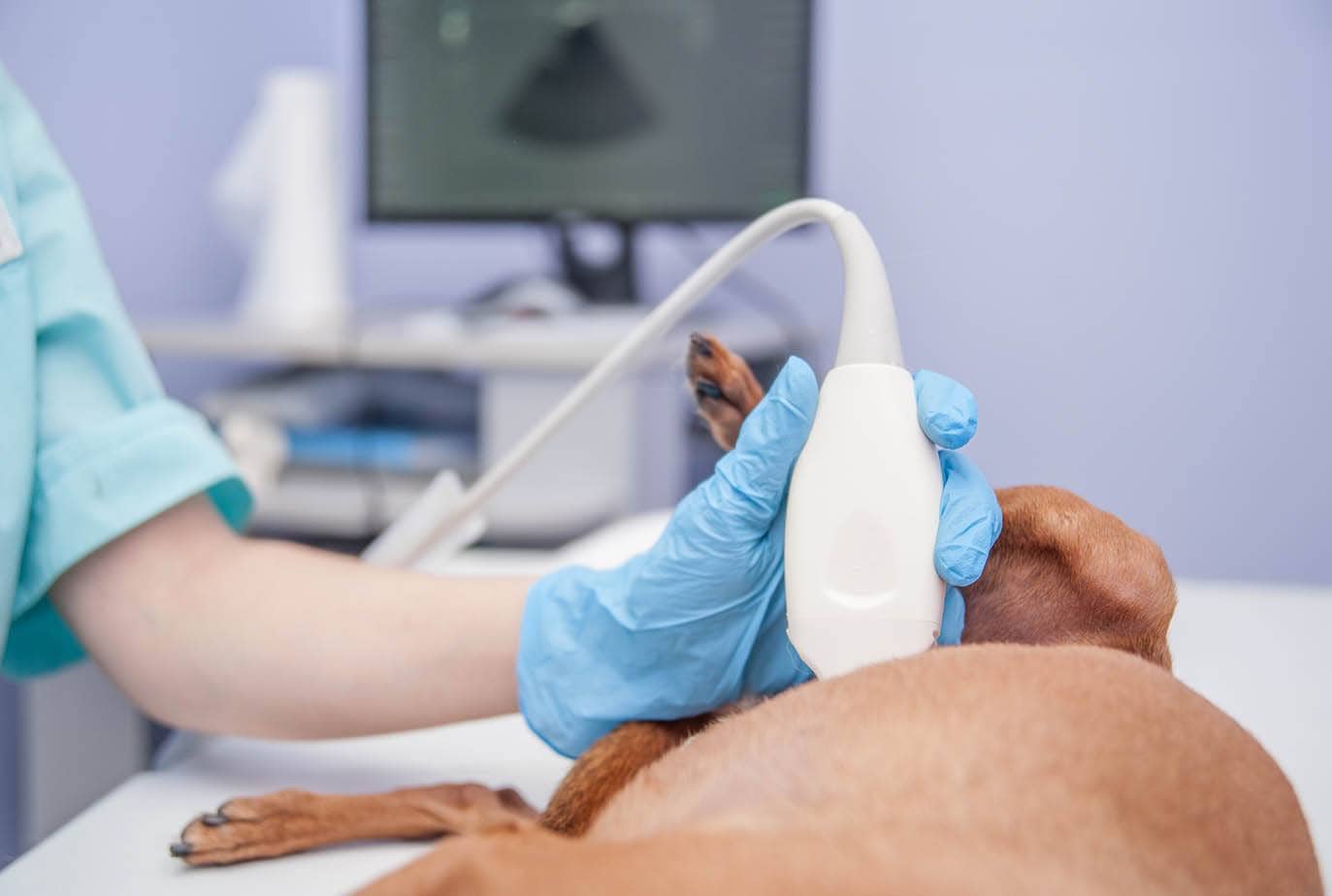
Sometimes, stillborn puppies can be delivered without further complications. However, a miscarriage can also result in a difficult birth.
Treatment
Since pregnancy loss can occur without any complications, these cases typically go unnoticed. However, complicated cases that cause infections or a difficult birth will require medical intervention, and the treatment will depend on the signs, presentation, and causes. A veterinarian will need to evaluate your dog to decide the best course of action.
2. Dystocia
What Is It?
Dystocia is essentially a catch-all term for difficult births. As such, several different things can cause dystocia. This is the main and most common abnormality that affects pregnancy and birth in dogs.
Causes
- Breed: Certain breeds are genetically predisposed to dystocia. Brachycephalic breeds are at higher risk than almost any other breed.
- Puppy Size: If a puppy is overly large, this can result in dystocia during birth. Oversized puppies may not fit inside the birth canal. This is most often a problem with litters that consist of a single large puppy.
- Puppy Position: Most of the time, puppies are born head or feet first. On occasion, a puppy will get turned sideways in the birth canal or come out bottom first. When this happens, the puppy often gets stuck, resulting in complications.
- Developmental Defects: Certain developmental defects can lead to puppies’ body parts becoming enlarged. This can lead to difficulties fitting in the birth canal.
- Miscarriage: Stillborn or mummified puppies might be passed through the birth canal, but their bodies can contort into unnatural positions, which can affect contractions and sometimes cause them to get stuck.
- Pelvic Canal: Even if the puppies are of normal size, if the mother’s pelvic canal is too narrow, it could lead to difficulties with delivering puppies. This is particularly the case with breeds that have large heads.

When to Call the Vet
If you have a pregnant brachycephalic female, make sure to consult your vet on a whelping plan or arrange an elective cesarean, as she is more likely to experience dystocia and not be able to safely deliver her puppies naturally.
- Your dog’s vaginal discharge is bloody, and the bleeding doesn’t stop after a few minutes or smells foul.
- There is a green thick discharge and no puppies are delivered.
- The pregnant mother is lethargic.
- The mother can’t stop vomiting.
- Stage one of labor begins when your dog’s temperature drops and generally lasts 6–12 hours. Call the vet if 24 hours pass after your dog’s temperature drops and whelping hasn’t begun.
- Regular contractions persist for more than 20 minutes without any pups arriving.
- The time between births exceeds 2 hours.
- The mother is pregnant for more than 63 days without going into labor.
- A puppy or a fluid sac is present in the birth canal but is not being delivered because it’s stuck.
- The mother’s rectal temperature is 39.4°C (103°F) or higher.
Treatment
After you determine there’s a problem and you contact your vet, they will first need to perform a physical examination. This will enable them to determine whether the pups can move through the birth canal. The examination might consist of a vaginal exam, X-rays, or ultrasound to establish the puppies’ viability. Once your vet diagnoses the issue, treatment can begin.
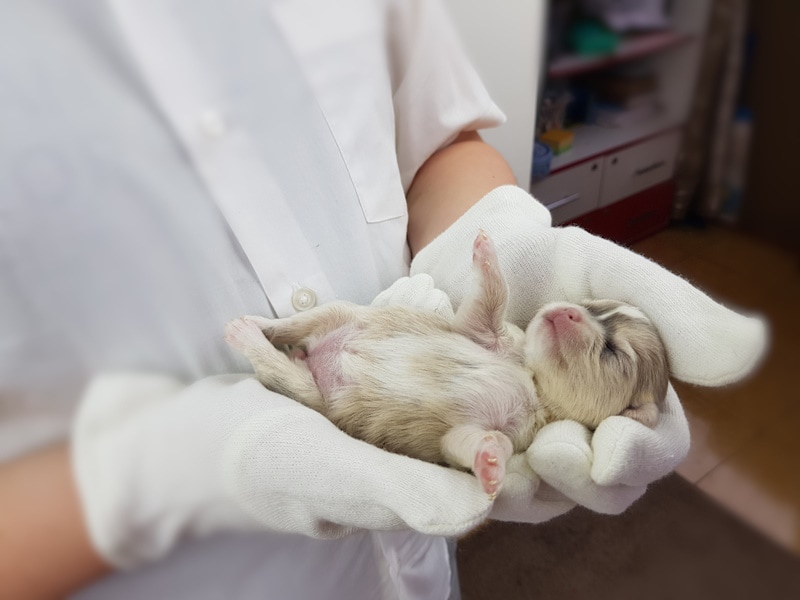
- Medication (oxytocin)
- Calcium injections
- Intravenous fluids
- Manual manipulation
- Cesarean section
3. False Pregnancy
What Is It?
This is a rather common occurrence that usually happens around the end of the heat cycle in dogs that are not actually pregnant. The dog will gain weight, her mammary glands might swell, and she can even start producing milk. Behavioral changes may accompany these physical changes. You might even witness your dog nesting or see a drop in appetite.
Causes
After the female dog has come out of heat, even if she didn’t get pregnant, she will still produce hormones that are meant to preserve the pregnancy, though there isn’t one.
In pregnant dogs, the hormones will continue being produced almost until whelping is due. In non-pregnant dogs, the levels of the hormones gradually reduce after 4 to 6 weeks, but its presence still causes the dog to exhibit signs of a false pregnancy. This may become more obvious as the levels drop further, which confuses the dog’s body into thinking that it’s going into labor, causing her to start nesting and develop enlarged mammary glands. It remains unknown why this phenomenon occurs in some intact female dogs and not others.

When to Call the Vet
If your dog is refusing food, acting out of sorts, producing milk, having enlarged or painful mammary glands, or licking her own mammary glands and nipples (leading to further milk production and even mastitis, in some cases), you should speak to a vet.
If you need to speak with a vet but can't get to one, head over to PangoVet. It's our online service where you can talk to a vet online and get the advice you need for your dog — all at an affordable price!

Treatment
False pregnancies aren’t usually treated because the signs tend to be quite mild and fix themselves within a week or two. If there is excessive milk production, your vet will prescribe medication to stop this. Some dogs may also develop mastitis, which will require treatment. You may need to put an E-collar on your dog or get her a pet shirt to stop the licking. If she’s “mothering” any of her toys, gently take them away. Focus on distracting her through plenty of exercise and playtime.

After Whelping
Besides abnormalities that occur before and during whelping, several conditions only present themselves after the whelping is complete and all the puppies have been delivered, including the following.

4. Mastitis
What Is It?
Mastitis is a condition that’s more common in cattle, though you will see it in dogs with some regularity. This is an inflammation and most often, infection of the mammary glands that occurs mainly in nursing females. It can also present in dogs experiencing a false pregnancy.
Causes
Mastitis is most commonly caused by bacterial infections. It’s usually triggered by a small and often unnoticeable trauma to the nipple, typically from the puppies suckling, that enables environmental bacteria to enter the mammary gland. It can be made worse if the dog is kept in unhygienic conditions or if she persistently licks her mammary glands. Mastitis can also occur if the puppies are weaned suddenly, not allowing a gradual decrease in milk production, such as in the case of puppy death.

When to Call the Vet
Check your dog’s teats and mammary glands twice daily, and make sure there are no signs of redness, swelling, pain, or change in milk color or consistency. If the milk becomes thick, pussy, or bloody; if the mammary gland is swollen, discolored, or bruised; if the gland develops open wounds, ulcers, or scabs; and if your dog becomes lethargic, has a poor appetite, vomits, or develops a fever, she will need to see your vet promptly. Severe and untreated cases of mastitis may progress to systemic illness and even sepsis.
Treatment
You can help prevent the possibility of mastitis by keeping your dog’s whelping box clean and dry, along with any spaces dedicated to raising the puppies. Your vet will prescribe appropriate treatment, which usually consists of painkillers and antibiotics. In some cases, the puppies may need to be weaned off their mother’s milk or fed a milk supplement instead. Some dogs may require an E-collar if they are licking too much.
5. Metritis
What Is It?
Metritis is when the lining of the uterus becomes inflamed due to a bacterial infection shortly after giving birth or experiencing an abortion or miscarriage. If left untreated, metritis can cause sterility and even septic shock, resulting in a life-threatening condition.
Causes
Metritis is caused by a bacterial infection, often assisted by trauma from obstetric manipulation during whelping, the presence of decaying or necrotic tissue in the uterus, or a placenta or a stillborn puppy remaining in the uterus instead of being passed.
When to Call the Vet
Signs of metritis include a distended and painful abdomen, lethargy, reduced or completely absent appetite, vomiting, dehydration, dark red gums, fever, and bloody or foul-smelling discharge from the vulva. Dogs with metritis might also neglect their puppies or experience reduced milk production. This condition always requires veterinary care, so if you notice any of these signs or if your dog is just not quite right, get her to a vet immediately.
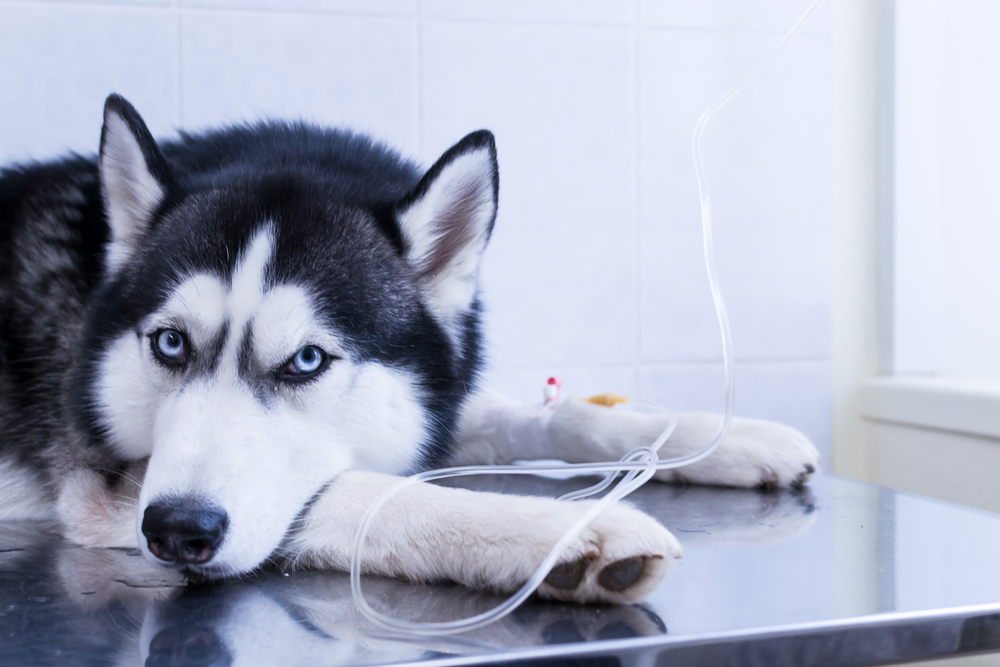
Treatment
Curing this condition often requires hospitalization. Your vet will first assess your dog and may perform blood testing and an abdominal ultrasound while putting her on an intravenous drip. Treatment will consist of systemic antibiotics, painkillers, anti-nausea meds, and other medications as required. In certain cases, oxytocin and prostaglandin may be used to help expel any leftover uterine content.
6. Eclampsia
What Is It?
Eclampsia is when a nursing dog’s blood calcium levels drop drastically, creating a life-threatening condition. It’s most common to see eclampsia in the mother when the puppies are between 1 and 4 weeks of age.
Causes
Eclampsia can be caused by the increased consumption of calcium during pregnancy or lactation, typically for building puppies’ skeletons and producing milk. Alternatively, it might be due to a dietary deficiency during pregnancy, such as from over-supplementation of calcium or a hormonal problem associated with the parathyroid gland. Small and toy breeds seem more predisposed to this condition.
When to Call the Vet
Eclampsia always requires veterinary treatment and is considered a medical emergency. The signs include restlessness, panting, stiff movement, muscle spasms, and convulsions. In rare cases, affected dogs might become aggressive, disoriented, or unsettled, or they may be pacing, panting, whining, or experiencing a high fever. Even if you just suspect that your dog may be at risk of eclampsia or is showing early signs of the condition, get in touch with a vet immediately.
Treatment
Your vet will administer calcium to your dog intravenously and prescribe oral supplementation. Some dogs may require further treatment in the case of muscle spasms or seizures. Do not give your dog over-the-counter calcium before consulting with the vet, and do not supplement it during the pregnancy unless recommended by your vet. Ensure that your dog is on a high-quality, balanced, and rich diet suitable for pregnant and nursing bitches, such as balanced puppy food.
7. Hemorrhage
What Is It?
Hemorrhage is generally described as blood loss and can sometimes occur during whelping.
Causes
Hemorrhage during or after whelping may occur due to the trauma happening inside the uterus, especially in cases of dystocia, where a puppy may have been stuck and damaged the uterus during birth. Manipulation of puppies during labor can also lead to hemorrhage, along with clotting disorders that may have gone unnoticed before.
When to Call the Vet
If you see significant blood flow following whelping, it could be a serious emergency, and you should contact the vet right away if it does not stop within a few minutes. Other signs of hemorrhage include collapse, pallor, hemorrhagic thick vaginal discharge (sometimes with blood clots), weakness, and shock. If excessive, this can be life-threatening.
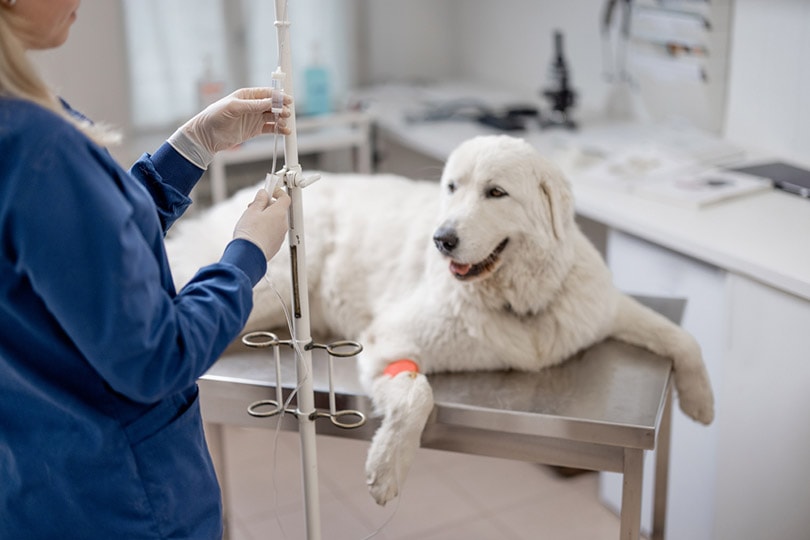
Treatment
Your vet will put your dog on a drip and check her red blood cells before deciding if she requires a blood transfusion. In cases of prolonged bleeding that cannot be controlled from the outside, surgery may be required.
8. Subinvolution of Placental Sites
What Is It?
Subinvolution of placental sites, or SIPS, is when the placental sites fail to heal properly. This causes several weeks of bloody uterine discharge and is most common in dogs under 3 years old that are whelping their first litter.

Causes
When a placenta is formed during pregnancy, cells from the developing embryo invade the uterine lining to form a closer connection. During whelping, the placentas detach, and the placental sites are expected to heal by sloughing these invading cells. In the case of SIPS, these cells remain in the uterine lining, causing ongoing bloody vulvar discharge beyond 6–8 weeks after birth. This is due to a yet unclear cause.
When to Call the Vet
SIPS will present with persistent yellow to red vaginal discharge and should always warrant a veterinary check-up. Similar signs may be present in cases of metritis, trauma, or a clotting disorder, and your vet can establish the exact cause.
Treatment
Most animals will seem well and will not require treatment, as the condition usually resolves on its own unless the blood loss becomes significant. Some dogs may require intravenous fluids, antibiotics, or in severe cases, a blood transfusion or surgery, though this is rare.
- You may want to read this next: How to Help a Dog in Labor

Conclusion
While most canine pregnancies go off without any complications, there’s always a possibility of something going wrong. Knowing the signs of abnormalities ahead of time and consulting with your vet can allow you to spot an issue when it first starts, which might give you a better chance of resolving the underlying problem without major health effects for the mother or puppies.
Hopefully, your dog will never experience any of these complications, but if she does, at least you’re prepared to spot the first signs and take action. Always consult with your vet if you have any queries or doubts about your dog’s health, and make sure you don’t miss any of her regular vet checks during the pregnancy, prior to whelping, and afterward.
Featured image credit: Gladskikh Tatiana, Shutterstock



